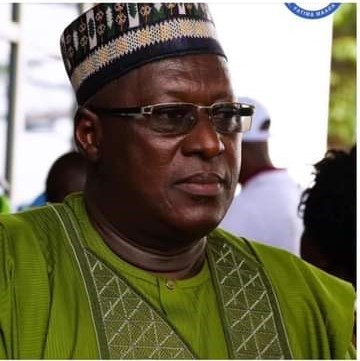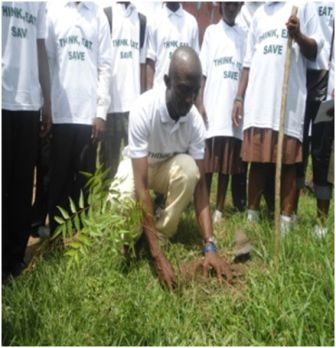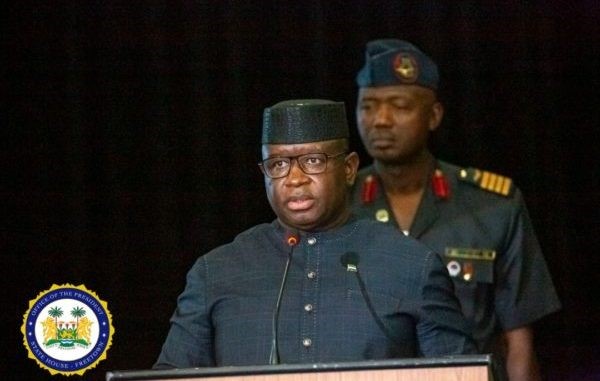SLPP Kailahun Youths Hail President Koroma’s Government
The Government of Sierra Leone through the Ministry of Energy (MoE) has embarked on a 8,880 solar street lights pilot project to be implemented in all four regions of the country – the South, East, North and the Western region respectively. (Photo: author, Alhaji Jalloh, IA, Saudi Arabia)
The development-oriented president, Dr. Ernest Bai Koroma, it could be recalled, has been telling Sierra Leoneans that by the end of his second tenure of office in 2017, all district headquarters and urban towns would benefit from solar street lights to improve safety and security. It is again at the background of the president’s avowed promise to the people that the pilot project has begun.
What one should not make light of is the recent installation of over 1,000 solar street lights in the opposition Sierra Leone People’s Party (SLPP) stronghold of Kailahun Town, the headquarters of Kailahun District, which shares borders with neighbouring Guinea and Liberia.
Kailahun District has a unique history of being the first area that was struck by the rebel war in March 1991, when the Revolutionary United Front (RUF) rebels invaded Bomaru and in less than one week, most of the towns in that district were systematically invaded by the rebels, including Koindu, Kailahun, Buedu, Kangama, Bunumbu, Bandajuma and many towns and villages, except Segbwema and Daru with a Military Barracks that resisted the rebel advancement.
The civil conflict left the district completely devastated especially the district headquarters which social infrastructure was left in ruins. The thermal plant that provided electricity for Kailahun was destroyed by rebels; government structures vandalized as well as private structures. Almost everything was destroyed in the township during the 11- year long war.
It therefore came as no surprise that the Koroma administration decided to prioritize Kailahun Town for the pilot project, given that the people have not benefited from general light for more than 22 years until this year.
The reaction of residents to this novel development in Kailahun is appreciation and praise for President Dr. Ernest Bai Koroma, who they see as an embodiment of development and the beacon of hope for Sierra Leonean’s prosperity.
Kailahun Town which had been in dark for more than two decades is the first district headquarters to have benefited from the solar street lights pilot project, while other district headquarters are poised to benefit from the project in fulfillment of the President’s avowed promise to prioritize the energy sector in the country before he leaves power.
“We’ll not forget President Koroma in haste because he has succeeded where our own political party, the SLPP, has failed”, were the exact words of Amara Ngobeh, a prominent SLPP youth leader of the district.
“For over 20 years, we were without light because of the war, but today President Koroma has provided it for us; may God bless him and we pray that he lives longer with better health to do more for us and the entire country,” Ngobeh told me in a brief telephone interview last night.
Thousands of Kailahun residents, Ngobeh added, most of them members of the SLPP have shoved aside partisan sentiments by openly praising and commending the APC Government for taking development to the township.
The installation of solar street lights in Kailahun Town is not the only development the current Government has embarked upon; the principal streets and roads leading to nearby towns and villages are being constructed. The Sierra Leone Water Company (SALWACO) is constructing pipe-borne water in the township, while a good number of Government structures that were vandalized during the war have been rehabilitated and new ones constructed.
Apart from Kailahun Township, the current Government has also taken more development strides in that district than many other districts. For example, the phase one of the Kenema/Koindu highway is under construction by a Chinese Company – ISU. The construction work started nearly two years ago, and when completed, it will rank among the best highways in the country.
Like the solar lights, the indigenes appreciate the road construction work; given that Kailahun District is one of the most agriculturally viable areas in the country with economic crops like; cocoa, coffee and timber, as well as bananas, plantains and vegetables, among others.
Steven Gondor, a farmer in Segbwema, also told me on the phone last night that: “When the highway is completed, I’m sure we’ll have added value for our crops because we’ll have no difficulty with taking them to the market”. He believes that once the road is finished, the difficulty of taking their produce to the market will be a thing of the past.
Back to the solar street lights technology being spread around the country, Government intends to roll out more lights to the major towns and eventually the 149 chiefdom headquarters after the current 8,880 solar street lights pilot project, that’s according to a recent press release from the Ministry of Energy signed by the Minister, Mr. Oluniyi Robbin-Coker .
The project which is funded with support by the Indian Government and supervised by the Government of Sierra Leone, the release added, could be termed as one of the country’s most important development initiatives.
“Already the project has provided the cities and big towns with solar lights as well as places like Hospitals, Police Stations, Schools, Barracks, Mosques and Churches and even Entertainment Centres all over Sierra Leone,” the release maintained.
Reports from Sierra Leone say President Koroma and his Government have been given a rousing welcome in formally launching the solar street lights in various regions in appreciation of fulfillment of his promise to prioritize the energy sector since he acceded to power in 2007. This clearly indicates that the President believes in action rather intentions.
With the rapid development and transformation in almost every sector, Sierra Leoneans are hopeful that before President Koroma leaves office by 2017, the country will become the envy of the West African Sub-region, given the rapid economic growth fuelled by activities in the extractive industry, and the massive investment in agriculture.
Stay with Sierra Express Media, for your trusted place in news!
© 2013, https:. All rights reserved.






